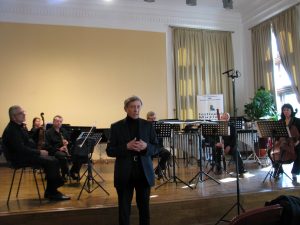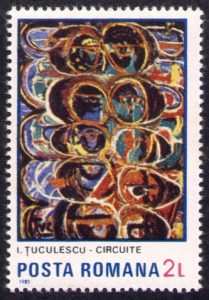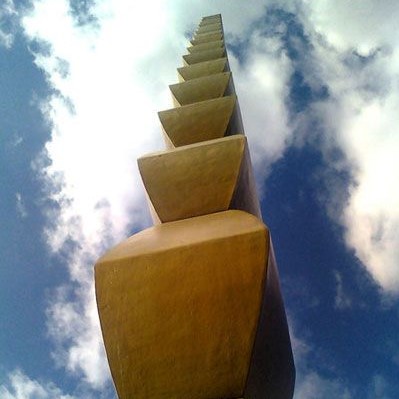Corneliu Dan Georgescu: Mr. Eternity
When I published a text titled Cornelia Dan Georgescu – a high-rank discovery on my blog at the very end of 2010, I became a true pioneer in our linguistic area: Georgescu was almost unknown here while some readings about him were only available in Romanian and perhaps also in German. The text, therefore, slightly agitated the entire (consisting of a dozen people) circle of enthusiasts of our interwar period neighbors’ modern music; I heard someone say that “nobody knows what it is about” and that I will need to write about him to the “Romanian” Glissando. Here it is, – even if it’s not for this particular issue yet.
Let us first say that Georgescu’s artistic output was personally recommended to us by Octavian Nemescu, a well-known representative of the most up-in-years generation of composers from the homeland of Eliade and Cioran, author of truly cult symphonies (and we know that he recommended to us his best friend’s work). Obtaining recordings of Georgescu’s music is not an easy task because there have been no commercial publications: we had to rely on very few dispersed works (e.g. available on YouTube) and a fantastic monograph included in a series of Romanian symphonic music (“ministerial” CD albums published in Romania, inaccessible in normal circulation) which contained Horizontals [Symphony No 2] (1980), In Perpetuum [String Quartet No 10], a trio, a septet dedicated to Brâncuși’s Columna del infinito and an undisputed masterpiece: the cantata for choir and orchestra Et vidi caelum novum (1996). Writing about his music, I will refer to these compositions, especially Symphony, and to some electronic pieces made available to us by the composer.
I still consider the short “glimpse” and the summary presented in the mentioned blog article to be accurate and valid (even if superficial) and what is important, the composer himself perceives them in the same way. He had one crucial objection, however: to appropriately understand or describe his music, it’s indispensable to refer to the category of sublimity. Without it, we can be stuck in complete misunderstanding of the subject, even if we seem to speak sensibly and to the point, for instance, in the following way:
Prof. Octavian Nemescu recommended to us Dan Georgescu’s music, pointing to the composer as an aesthetic relative of La Monte Young; he argued that it’s music of the “stopped time,” as if frozen and motionless. However, I feel that Morton Feldman would be a better point of reference here: the American composer’s name would put listeners more on the right track, even if the comparison with Young is technically more accurate. The second point of reference could be found in Georgescu’s folklore studies. The composer used to write expert papers on the typology of folk dances and shepherd’s signals. The third one is archetypicality stemming from the studies and meditations over the works of Brâncuși (who inspired many Romanian composers), which means searching for elementary, primary structures and music based on universal rules that are recognizable everywhere and forever. Eventually, very important inspiration by works of the Romanian painter Ion Ţuculescu, who combined abstract expressionism with references to folk art.
Significantly, escaping the standardized academic avant-garde (serialism, aleatory), Georgescu followed the example of visual artists. Analogically, the Polish composer Zygmunt Krauze (a representative of the same generation) in his works invoked Władysław Strzemiński’s concepts of unism (Andrzej Panufnik could be mentioned here as well as he was inspired by “geometrical mysticism” of a folk cut-out; an artist particularly crucial to Georgescu is Piet Mondrian to whom the composer dedicated the whole cycle of compositions for string quartet and electronics) And last but not least, let us mention the Polish avant-garde which was very important to the generation to which Nemescu and Georgescu belonged: Dimensions of Time and Silence are not as distant from the content of this album as one would think. Just as Górecki’s Old Polish Music or the initial passages of Lutosławski’s symphonies.
All this results in highly original and fascinating music, sometimes described as Romanian minimalism. Similarly to Brâncuși’s pieces, it is sophisticated and elementary at the same time. It gives an impression of the eternal flow, even though it is finished and closed, often characterized by such paradoxical juxtapositions as the above (Georgescu himself used similar tone to speak about Brâncuși, especially of his Endless Column). Symphony No 2 sounds a bit like rattling of tin bells carried by cows and sheep grazing in pastures of the Carpathians and the Alps, interlaced with the sounds of trembitas (the Romanian equivalent is called bucium): the effect achieved with the significant help of percussion including idiophones of various kinds such as, if I hear well, tubular bells and perhaps even Asian (Tibetan) instruments.
 All the above (quoted from the blog) is right but only in the context of—fundamental for the composer himself—the category of sublimity. It is extremely important to emphasize that Georgescu’s music (as well as aesthetically consubstantiate works by Nemescu) is a truly original phenomenon, strictly linked with idiosyncratic background of Romanian culture, what Harry Helberich called “a specific anthropological substratum” on which—directly and naturally—spectralism (and “archetypism”) sprouted up. Such composers as Nemescu and Georgescu speak of music and art using terminology as if taken straight from Mircea Eliade, but when asked about this association, they come to conclusion that their style of thinking and their system of notions have been worked out independently of the great philosopher’s ideas (Nemescu’s press conference at the Warsaw Autumn Festival, 2011).
All the above (quoted from the blog) is right but only in the context of—fundamental for the composer himself—the category of sublimity. It is extremely important to emphasize that Georgescu’s music (as well as aesthetically consubstantiate works by Nemescu) is a truly original phenomenon, strictly linked with idiosyncratic background of Romanian culture, what Harry Helberich called “a specific anthropological substratum” on which—directly and naturally—spectralism (and “archetypism”) sprouted up. Such composers as Nemescu and Georgescu speak of music and art using terminology as if taken straight from Mircea Eliade, but when asked about this association, they come to conclusion that their style of thinking and their system of notions have been worked out independently of the great philosopher’s ideas (Nemescu’s press conference at the Warsaw Autumn Festival, 2011).
Analogically, when questioned about the phenomenon of American minimalism derived from Young and the “atemporal” Romanian school, they claim that they were by no means influenced by Americans and that it is rather an often-encountered phenomenon of simultaneous eruption of the same trends, concepts or discoveries in different parts of the world. In my view, the originality and greatness of the almost-unknown-to-us Romanian culture is manifested in Georgescu’s works (as in Symphony No 2) in a special way. Austere sublimity of his music and its maximalistic (in terms of the effects, sound and narrative) minimalism as well as the arrangement of large forms based on elemental, “poor” elements and gestures, its apparent simplicity and spectacular “banalism” (electronic music!) makes this Romanian Berliner an individual and an extraordinary figure at least on the continental scale; it might be somewhat misleadingly (flamboyantly) say that Scelsi is just one step further.
***
This is what attentive listeners can deduce on their own, but we inquired about it the composer himself and from these conversations we extracted the main threads, which will be presented in the form of an essay, not an interview. We will be glad, on the other hand, to quote the composer.
Sublimity, eternity, infinity
The key meaning of sublimity for Georgescu is that he understands music as an art form expressing an idea or “a premonition of infinity.” Music is a creation of a human spirit which—in some way—can be considered “a special form of matter.” The human “perspective of infinity” specifically and exclusively is and should be the product of a spiritual being. Artistic music has “spiritual” obligations: it is not a game or an anecdote, but a window to infinity; it is “something transcendental, beyond sounds, instruments, intervals, forms and structures.” In this context, sublimity can be interpreted as longing for the eternal and the infinite: the most possible comprehensive feeling experienced as painful “lack” (“the missing All”) of something that cannot be embraced or comprehended, but what we sense as great, magnificent, and liberating. After all, Georgescu himself notices that “sublime is inseparable of tragic.”
The example of quite literal execution of the ambitious plan to express the premonition of infinity are electro-acoustic compositions (especially Corona Borealis. Atemporal Studies no. 1 from 1980) which, according to the artist, do not have either a beginning or an end and they are intended to be a certain “state,” a “vibrating space.” Closing them in a defined period of time is purely a consequence of a technical necessity, while the existing pieces are in such a relation to the deliberately “infinite” composition as a single human life to eternity. This is a window which opens a new perspective.
Archetype and time
“Composing as contemplation of a musical archetype:” this is the best recapitulation of what Georgescu says about his own music, pointing to Jung’s (“musical,” not sound) archetypes of the collective unconscious. What is essential and most powerful in these works is not how originally the composer captures the musical material, plays with it, and reshuffles it. One could even say after Scelsi that Georgescu “does not compose,” i.e., he does not add one thing to another. He doesn’t arrange sounds, but rather contemplates archetypal figures and turns towards the sources of music, its basic components, pure elements. As Michał Mendyk duly noticed and Octavian Nemescu confirmed (during the mentioned press conference at the Warsaw Autumn Festival in 2011), in compositions characteristic to this particular trend in Romanian music, the so called musical material is of secondary importance, because what is more significant is the organization of time.
Additionally, Georgescu’s approach is founded on the idea of the “stopped time,” The time is somehow “frozen,” in opposition to the linear or circular time indicating “movement.” It may be called “open,” picturing the “eternal stillness.” The Romanian common ground with the Orient and the specific relationship of this strange country with India or Tibet are by no means extravagant intellectual figures. They are truly tangible, although they might seem strange to us (I recommend trekking across Romania; let us take two geographical names: Rishikesh and Maramuresh: which one is Indian and which is Romanian?). This type of “stillness” does not stem from negating movement of spheres and the world’s never-ending bustle, but from looking at them from the perspective of eternity, where they are simply glimpses and short moments in the “Great Resting Wholeness.”
Visual art Patterns
 Extensive cycles of Gergescu’s pieces inspired by works of distinguished plastic arts representatives (Mondrian, Brâncuși, or Ţuculescu) not only provide rich material to study the relation of music with painting and sculpture (an obvious one in this case) but also suggest that the composer wanted more than to celebrate the memory of his favorite artists or illustrate their artworks with music—his goals are much more far-sighted. It’s the first deep conclusion drawn on the basis of listening to these compositions: painting and sculpture seem to be here an inspiration and an “example” (a model) for the art of sounds, not an object of sighs and adoration. In this perspective, the closest Polish “relative” of Georgescu would be Zygmunt Krauze, the fact readily admitted by the Romanian composer who prefers Krauze’s output among Polish music.
Extensive cycles of Gergescu’s pieces inspired by works of distinguished plastic arts representatives (Mondrian, Brâncuși, or Ţuculescu) not only provide rich material to study the relation of music with painting and sculpture (an obvious one in this case) but also suggest that the composer wanted more than to celebrate the memory of his favorite artists or illustrate their artworks with music—his goals are much more far-sighted. It’s the first deep conclusion drawn on the basis of listening to these compositions: painting and sculpture seem to be here an inspiration and an “example” (a model) for the art of sounds, not an object of sighs and adoration. In this perspective, the closest Polish “relative” of Georgescu would be Zygmunt Krauze, the fact readily admitted by the Romanian composer who prefers Krauze’s output among Polish music.
It would be an obvious mistake to believe that the artist wishes to somehow “translate” the visual onto the sonic: in this sense, he doesn’t “pattern” himself on the painting. It is more a question of “a specific aesthetics or a symbolic meaning of certain techniques and procedures. Why wouldn’t we perceive a painting as a model?”, the composer asks and then adds: “This form of art evolved faster and was always more modern than music. The resemblance in terms of formal abstraction might help us obtain the desired, new perspective, at the same time remaining outside the music fashion.” Nonetheless, there hasn’t emerged Romanian music yet which would be distinguished by the essentiality that Brâncuși’s sculpture already achieved in the 1930s.
Nevertheless, this approach results in rich and fruitful “suggestions” for musical output; in the case of Georgescu, the very choice of “plastic arts patterns” is very meaningful: Brâncuși is somewhat a forerunner of minimalism as an artistic thought (and, of course, a founder of Romanian “archetypism” in music); Ţuculescu “combines, as no one else, naïve folk features and the mood of tragedy,” while Piet Mondrian “in a sharp opposition to this folk-decorative expressionism” creates “a radical, ‘objective and pure’ aesthetics based on geometry and primary colors, beyond any ‘style’ or affiliation with space and time.” Georgescu admits that the last two patterns helped him accommodate his own internal artistic contradictions as both have features of “primitivism:” the first one is chaotic, the second one geometrical. In this context, the primitive and the archetypal seem to be inseparable, similarly to the tragic and the sublime. The combination of the two with the already mentioned idea of atemporality, creates “a family of notions” that are perhaps the ultimate key to the work of Georgescu, the compatriot of Brâncuși and Ionesco.
Romanian in Berlin
Georgescu is a citizen of Berlin and he is glad he chose this particular place on earth, although it is not difficult to detect a note of bitterness in this declaration. He emphasizes that as an artist and a representative of (atypical of [Western] Europe) Romanian culture, he is perceived as a rarity, an odd exception, an “alien,” and he remains not fully understood. Basic assumptions of his music are perceived by Germans as strange and obscure, even if today German music stands for something incomparably more than Darmstadt serialism “with appurtenances.” Nevertheless, this is where a certain model or archetype for the entirely new German music has been created. One can act along or against it, but being German and thinking in German, one is always in its range. Eventually, the composer finds some positive sides of this situation, as if he didn’t want the feeling of ostensible understanding, acceptance, and familiarity to blot out the truth about his position as an artist. Michai Mitrea-Celarianu—respected by Georgescu and his friend Nemescu—died in Paris completely forgotten, just like in his homeland. Therefore, choosing Berlin and discarding Bucharest and Paris appears as rejection of any illusions Georgescu had about the role and rank of an artist in the wor
translation: Marta Skotnicka


